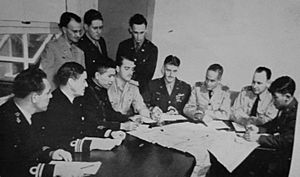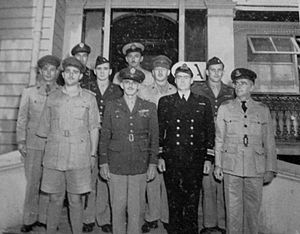Allied Translator and Interpreter Section facts for kids
The Allied Translator and Interpreter Section (ATIS) was a special group of Australian and American intelligence experts during World War II. It was like a central hub for all the Allies to work together. Their main job was to translate secret Japanese messages, question prisoners, and help with talks in the Pacific Ocean area from September 1942 to December 1945. ATIS also looked into important matters from the war in its final months. This section officially closed down on April 30, 1946.
Contents
How ATIS Started
Before ATIS, different Allied military groups handled translations and intelligence separately. But in February 1942, Lieutenant Colonel Sidney Mashbir was asked to lead a new "Translator and Interpreter Unit." This unit was part of General Douglas MacArthur's headquarters in the South-West Pacific.
By August 1942, General MacArthur realized they needed a bigger, more organized group. He wanted a "centralized intelligence organization" with many language experts. This new group would help understand captured documents and question prisoners of war. It would also share this important information with all Allied forces.
So, on September 19, 1942, the Allied Translator and Interpreter Section was formed. It combined the US "Translator and Interpreter Unit" (which had nine men) with Australia's "Combined Services Detailed Interrogation Centre" (which had 17 people). ATIS was a joint group involving different Allied services. It started in Indooroopilly, Brisbane, Australia.
The ATIS headquarters moved several times during the war. It went from Melbourne, Australia, to Hollandia, Dutch New Guinea. Then it moved to Leyte Island and Manila in the Philippines. Finally, in October 1945, it moved to Tokyo to help with the occupation after the war.
ATIS began with 25 officers and 10 enlisted men. But it grew very quickly as its work expanded. By September 1944, ATIS had 767 people. At its busiest in 1945, almost 4,000 men and women worked there. Most of these were second-generation Japanese Americans, known as Nisei.
From the start, ATIS needed more skilled translators. In September 1942, a magazine called Life said that fewer than 100 non-Japanese Americans could speak Japanese well. It even quoted someone saying there were only "three Americans with full command of the language" when the attack on Pearl Harbor happened.
What ATIS Did

The Allied Translator and Interpreter Section was led by Mashbir and was part of the Military Intelligence Service (MIS).
ATIS followed three main rules for its operations:
- All language and translation resources in the Pacific would be shared.
- Differences between Allied services and countries would be removed.
- All gathered intelligence would be given to all Allied services at the same time.
The main goal of ATIS was to bring together all Allied intelligence in the South West Pacific Area. However, its work soon spread to other Pacific areas. They worked with other groups like the Joint Intelligence Center - Pacific Ocean Area. ATIS also analyzed Japanese military goals and abilities. They even looked at the political and psychological reasons behind Japanese actions. Later, ATIS became very important in creating propaganda and psychological warfare.
The Japanese thought the Allies could not read their secret papers. So, they did not take many security steps. This was a huge reason why ATIS was so successful at decoding messages. During its time, ATIS linguists questioned over 14,000 prisoners. They also read, summarized, or translated two million documents. They shared over 20 million pages of intelligence reports about the Japanese. To get documents and question prisoners right after they were captured, ATIS linguists joined every Allied attack. At least 17 linguists died while doing this dangerous work.
Nisei Linguists and Operation Z Plan
- Further information: Operation Z (1944)
ATIS was started in 1942 by General MacArthur in Melbourne, Australia. The agency hired over 3,000 Nisei linguists. These Nisei were Japanese Americans who played a key role in translating the Z Plan. They also translated more than 350,000 captured Japanese documents. This was like translating 20.5 million pages of text!
Many Nisei linguists were proud to show their loyalty to the U.S. However, they also had mixed feelings. The same government that used their language skills in the war had also sent their families to internment camps.
The "Z" Plan story began on the night of March 31. Admiral Koga and Admiral Fukudome flew on separate planes to Davao. Admiral Fukudome carried a red leather book with the "Z" Plan inside. Soon after they left, Koga's plane crashed in a tropical storm, killing everyone. Fukudome's plane survived the storm but used most of its fuel.
Fukudome's plane was heading for Cebu island, but the pilot misjudged the landing. It landed in the Bohol Strait, 2.5 miles from shore. As the plane sank, Fukudome and 12 others escaped the burning wreckage. On April 3, a Filipino man named Pedro Gantuangoko found an oil-covered box. Inside, he discovered the red leather book with the "Z" Plan. Gantuangoko hid it, thinking it was important.
Meanwhile, Fukudome and the Japanese survivors were rescued. They were then captured by Filipinos. These Filipinos took them into the hills to a guerrilla aid station. This station was near Caloctogan, home to the Cebu Area Command, led by U.S. Lt. Col. James M. Cushing. Cushing had heard from intelligence in D.C. that the Japanese were desperately looking for something lost in the plane crashes.
The next day, the Cebu Area Command went back to the village. They questioned people to find the missing box. Meanwhile, Gantuangoko gave the box with the "Z" Plan to local guerrillas. They then sent it to Cushing. The Z Plan was quickly sent to ATIS in Australia. Once ATIS translated it, the "Z" Plan was shared with every command in the U.S. Navy.
Important Achievements
ATIS had several important achievements during its operations. One major success was translating and analyzing the captured Z-Plan in 1944. This plan showed Japan's defense strategies against Allied attacks. It specifically detailed plans for places like the Mariana Islands in the Pacific. The United States wanted to capture these islands to use them as bombing bases against Japan. The Z-Plan also included Japan's strategy for a big, decisive battle against the Allied forces.
See also
- Japanese prisoners of war in World War II
- Military Intelligence Division
- Military Intelligence Service
- Sidney Mashbir
- Z Plan (Japan)


